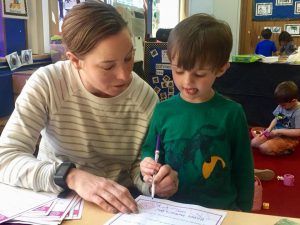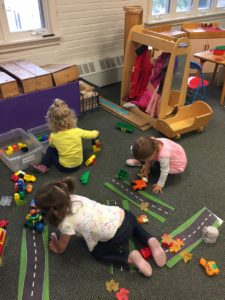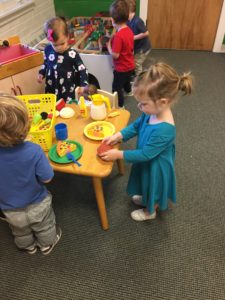 We know from educational research that children learn by doing. Through active involvement with their environment, children are better able to make sense of the world around them. By interacting with their physical and social environment, children continually broaden their frame of reference. The richer the environment, the more opportunities there are for children to learn by doing. As such NCNS has adopted The Creative Curriculum model. The role of the teacher in the Creative Curriculum is to create an environment that invites children to observe, explore, inquire, experiment and make choices.
We know from educational research that children learn by doing. Through active involvement with their environment, children are better able to make sense of the world around them. By interacting with their physical and social environment, children continually broaden their frame of reference. The richer the environment, the more opportunities there are for children to learn by doing. As such NCNS has adopted The Creative Curriculum model. The role of the teacher in the Creative Curriculum is to create an environment that invites children to observe, explore, inquire, experiment and make choices.
In The Creative Curriculum, the children’s social-emotional development goes hand in hand with their cognitive development. As they play and interact with the classroom environment, the children are learning about sharing and cooperation. Teachers promote development of the whole child by recognizing the connection between cognitive, social-emotional, and physical growth.
A key objective of The Creative Curriculum is to help children develop a positive attitude toward learning. The focus is on the environment where learning takes place. Units or themes still have a place in The Creative Curriculum, but the emphasis is on designing ways in which concepts and understandings can be acquired through the activities and interests of the children in each classroom. Therefore, themes explored in one geographical region may be different than the themes explored in another area since each theme must begin with what the children know and see every day.
The concept of free play is also fundamental to The Creative Curriculum. During this time, children can select activities in the various interest areas throughout the classroom. Children are free to choose as many activities as they want or spend all their time in one area or on one activity.
Through quality play activities, children gather valuable information and develop critical skills that will support academic success. So what does child’s play really mean?
Pretend Play
Children acting out real life or imaginary experiences are trying to make sense or feel in control of their world. 
Art
Scrubbing, tearing, cutting, painting, rolling and pounding clay are all art experiences that help children learn how the mind and hands can work together to create. Art assists in gaining control of the hand muscles (fine motor development), which is necessary for pre-writing. Art experiences can also prepare children for math and science by using colors, textures, forms and shapes.
Language
Written and spoken words will help children develop a love for reading that will flourish over a lifetime. When children use their own language to express feelings or thoughts, they begin to feel the power of speech. When they sing, listen to poetry, are read to, and are given time to review books, they experience the joy of the written word.
Music
Music and moving the body informally help provide children with a physical outlet. Soothing music can ease fears and anxiety, whereas dance music can help children develop motor skills, be silly and have fun. Singing helps children integrate new words into their vocabulary and experiment with speech patterns.
Manipulatives
The doors to the world of math are opened wide with manipulatives such as stacking blocks, pegboards, and stringing beads, because they offer opportunities to classify, sequence and sort items, which is math. Decision making, planning, sharing, cooperating, sense of accomplishment, and pre-math skills are just a few of the familiar skills that a child will develop in the block area.
Science
Basic cognitive skills of cause and effect are all gained in this exploratory area.
What happens when children play?
Children are testing and finding out about the world. Small parts of it are theirs to try to understand, to learn more about.
Children are beginning to understand people and the importance of their feelings. They are trying to deal with the real life they see.
Children are learning about their own feelings, how to express them, and how to handle them.
When children can choose, make decisions, and relate to others in play, they are learning self-discipline.
As children play in a safe and nurturing environment, they are becoming more secure of themselves, making their own plans, and learning to judge what’s best.
In purposeful play, children are learning to think because they are:
– Talking
– Trying new ways
– Organizing ideas
– Solving problems
– Repeating what works
– Challenging themselves
– Setting tasks for themselves
Children are making friends by doing things together. Sometimes young children approach others in ways that are difficult to understand – like hitting, pushing, or sitting silently near each other. Often an adult can suggest a more successful approach: “Matthew, Randy doesn’t like you to knock his garage down. You can tell Randy you want to build with him. What are you both going to build this time?”
Children at play are not waiting to be entertained. They are finding the joy or achievement – the source within themselves for happiness all their lives.
Children need to have fun and know how to create fun. Unless nurtured in childhood, our capacity for joy is diminished and as adults we are cheated.
